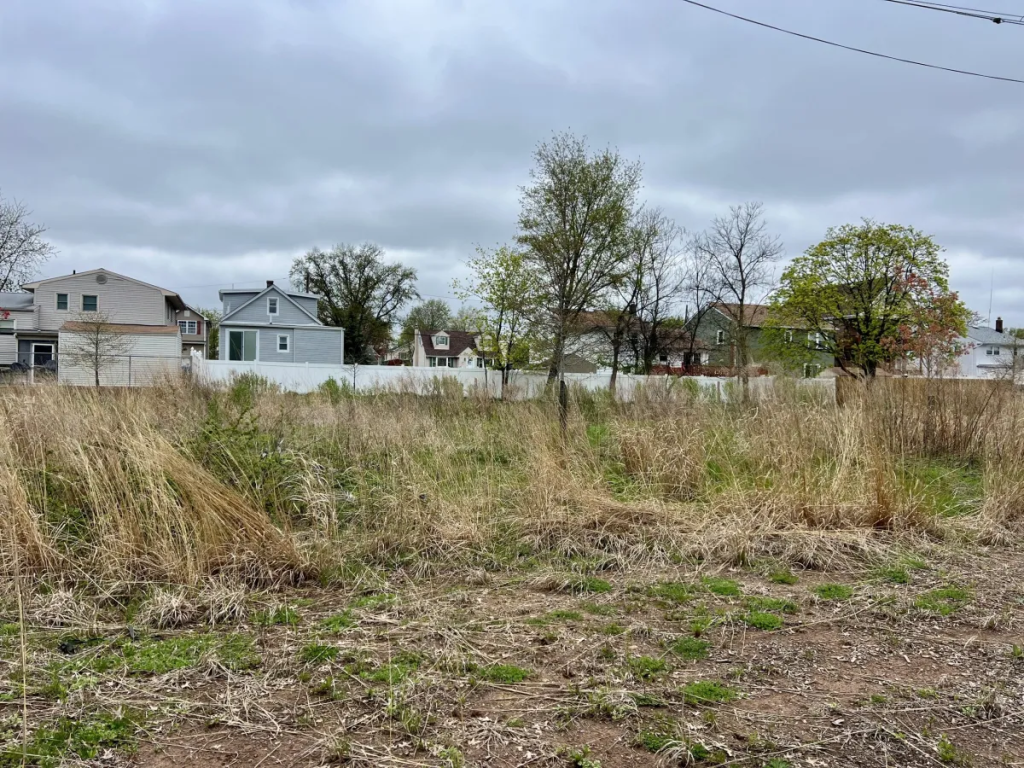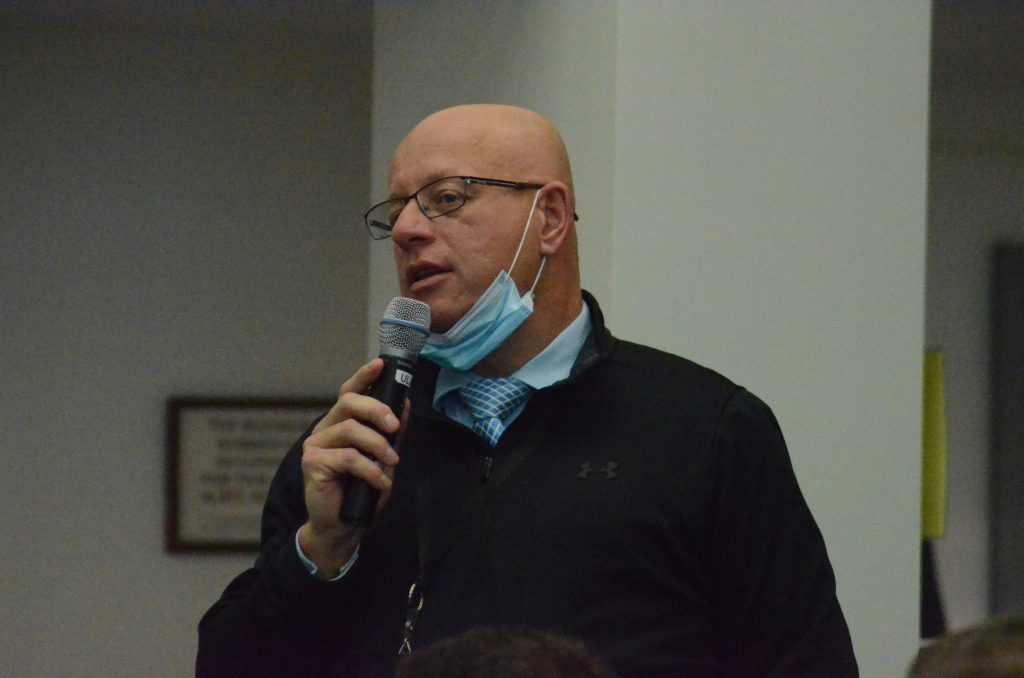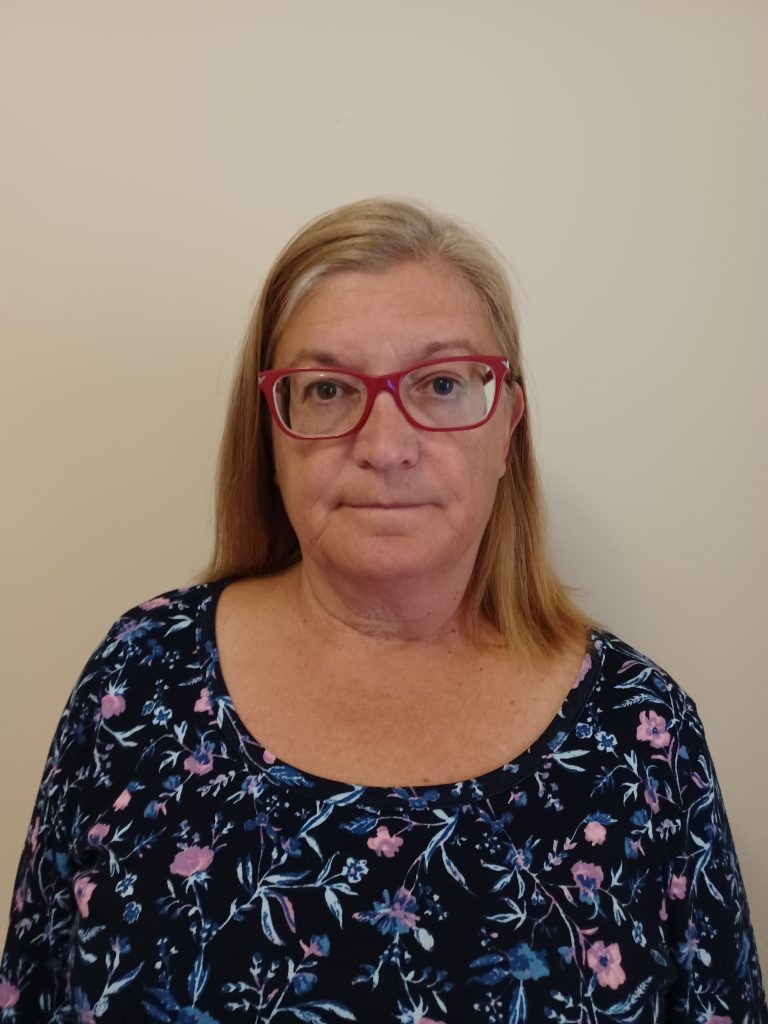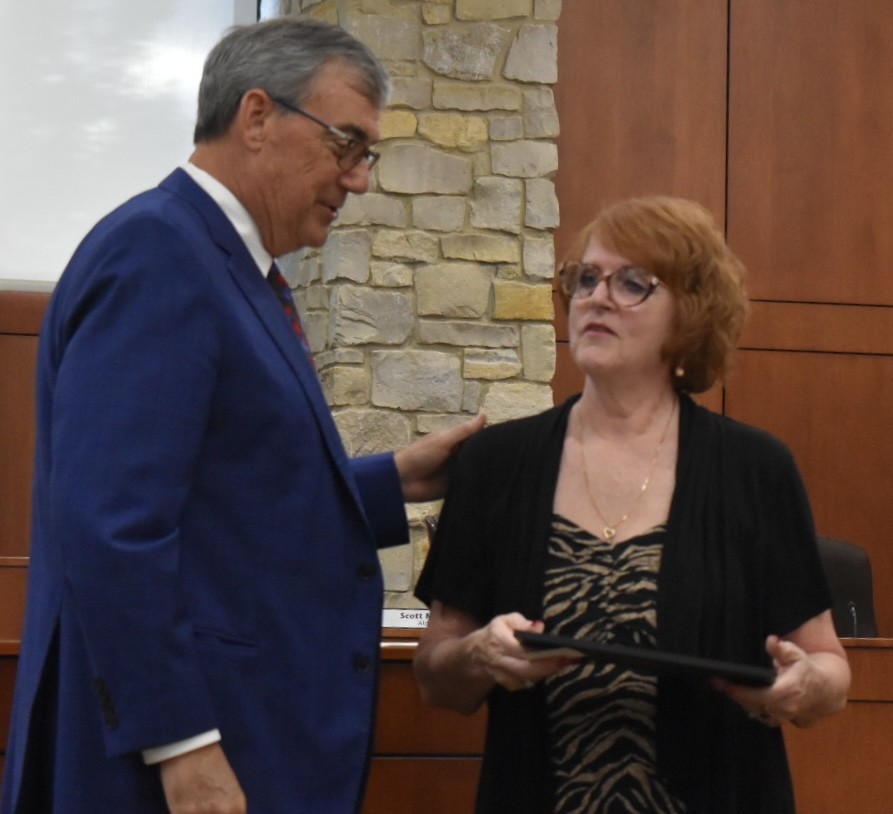
This Coastal State’s Approach to Flooding May Be a Model for Illinois Communities
This story was originally published by the Illinois Answers Project.
Editor’s note: This is the second story examining government home buyouts. Read part one, which focuses on Illinois’ program, here.
WOODBRIDGE TOWNSHIP, N.J. – In an area once dotted with single family homes, a one-mile gravel path weaves through wetlands, thousands of native plants and rain gardens.
The New Jersey Turnpike quietly whirs in the background of the 30-acre restoration park, located on the edge of a neighborhood in the manufacturing and warehousing town of about 100,000, less than an hour from New York City.
In 2012, Superstorm Sandy swept through and damaged hundreds of homes. That year, officials from Woodbridge worked with the state to buy and demolish 171 single-family homes through a program called Blue Acres.
After the homes were torn down and most families moved away, ecologists from Rutgers University designed the restoration area to absorb rainfall and flood waters from the three waterways that bound the park from the north, south and east.
The park – and how the state helped residents move out of a floodplain – is a blueprint for other states and communities facing recurrent flooding, climate experts say.
“One of the reasons that [Blue Acres] is pointed to so often is that because it is big and prominent and well funded,” said A.R. Siders, a climate researcher at the University of Delaware. “It is also able to do things that are creative.”
The state recently launched a pilot program to address a key concern after homeowners agree to a buyout: where they go next.
For decades, local, state and federal governments have worked with residents to buy their properties, tear down structures and turn the land into open space in order to mitigate flooding. Buyouts are a common practice in New Jersey, which faces coastal flooding in addition to riverine and urban flooding. It’s also happening in Illinois, where flooding is the state’s most prominent natural disaster, according to state experts.
Illinois’ buyout program has benefited thousands of residents, particularly when their options are limited. But the program faces inconsistent funding and is known for taking too long to get residents much-needed cash to move away. When they are able to leave, there’s no guarantee they’ll be able to afford to move to a flood-free area.
Read More: For Many Illinoisans in Flood-Prone Areas, Buyouts Are the Only Way Out
Blue Acres and New Jersey face similar problems, but they have the funding and resources to make it a more proactive, adaptive program, experts told Illinois Answers.
“It’s difficult to even define what success means in terms of a buyout,” said Anna Weber, a policy analyst at the Natural Resources Defense Council in Washington, D.C.
But “there are a lot of really useful lessons that we can apply from Blue Acres to other programs,” she said. “There is a lot of deliberate learning and applying of lessons within the Blue Acres program … and there’s a lot of opportunities to learn from the experiences of that program in other places around the country.”
Blue Acres’ Model
Since 1995, Blue Acres has purchased about 1,100 homes, the majority acquired after Superstorm Sandy in 2012, said Courtney Wald-Wittkop, who runs the program at the New Jersey Department of Environmental Protection. The year after Sandy, the federal government allocated $300 million to acquire and demolish homes.
In addition to federal funding, every year since 2020 Blue Acres has received a portion of the state’s corporate business tax, thanks to voters who approved a constitutional amendment dedicating funds to environmental, conservation and preservation programs.
The yearly amount varies based on the revenue collected. In 2023, Blue Acres received $10 million, which will be spent over a few years, Wald-Wittkop said.
New Jersey’s state-based funding source “allows the program to be much more nimble and flexible, in some ways, than programs that are specifically relying, for example, on FEMA funding sources,” Weber said.
That consistent funding allows Blue Acres to move quickly on a sale so homeowners don’t have to wait for federal funding, Wald-Wittkop said. FEMA-funded buyouts take a median of more than five years, according to a study by the NRDC.
Blue Acres aims to complete sales within six to 12 months, Wald-Wittkop said, but factors such as funding availability, title complications and the homeowner’s responsiveness can slow the process. The homeowner can also appeal the appraised value, which can add time.
Many homes in or around the restoration area in Woodbridge Township, New Jersey, are elevated to prevent future flood damage. The restoration area, to the left, has been reclassified as an open space conservation and resiliency zone, which places stricter flood protection measures on residents who live there. (Credit: Laura Stewart, Illinois Answers Project)
Siders, who studied Blue Acres as a part of her research on climate change adaptation policies, said it has been “able to overcome challenges that are really common in buyout programs.” For example, Blue Acres brought together civil engineers and real estate experts to speed up home evaluations, and it helped homeowners “who were underwater on their mortgages to be able to be eligible for the program, which normally they would not be.”
Blue Acres also assigns residents a case manager.
“The Blue Acres program has had a big focus on the resident experience in the form of case management, as well as what we might call wraparound services,” Weber said. Those services could include help working with the bank, finding a new home or assisting with the moving process – all things not included in federally funded acquisitions, she said.
Wald-Wittkop said case managers understand the needs of the homeowners, which helps speed up the process. She pointed to feedback from case managers, who noticed that some homeowners were hiring attorneys to handle simple closings, which was causing delays. Because of their input, program officials recommended the state use a title company to close on some properties on behalf of the homeowner, making the process more efficient.
Illinois’ Flood Hazard Mitigation Program, in comparison, does not provide case managers. It is one of two buyout programs in the state and is funded by state legislature allocation, which often runs dry. The other program is federally funded only after natural disaster declarations.
The Flood Hazard Mitigation Program in the Illinois Department of Natural Resources has one staff member, who works with another state agency to close on the homes. Blue Acres, on the other hand, has about 19 full-time positions, Wald-Wittkop said, and is part of the Office of Climate Resilience, which has about 40 staff.
Read More From This Series:
Flooding: Illinois’ Most Threatening Natural Disaster
Chatham Flooding Mitigation Program Flounders, But Oak Park Sees Success
‘Green Alleys’ Prevent Flooding, But Vulnerable Neighborhoods Must Wait
Addressing the Lack of Affordable Housing
A common challenge with buyout programs is that residents are often left to find new – and hopefully affordable – housing on their own, Siders said.
The focus is often on getting people out of their homes, but not necessarily on where they go next. Buyout programs are very rarely tied to discussions about where new housing is being built, how much new housing is being built and affordability, she said.
“There’s kind of a disconnect there,” she said.
New Jersey is aiming to address this disconnect with a pilot program that will build affordable housing for Blue Acres participants and first-time homebuyers.
Launched in October 2023, the Smart Move Program seeks to “keep residents in New Jersey with affordable housing and put them in a safer location than where they currently were,” said Jim Mooney, who runs the program at the Department of Community Affairs.
After Hurricane Ida in 2021, the state invited local governments in 12 counties most affected by the storm to submit a development plan for an affordable housing project.
The development has to be outside the 500-year floodplain, contain at least six single-family housing units and serve mixed-income households. The department encouraged applicants to come up with innovative and resilient development ideas, Mooney said, like buildings with heat-absorbing glass or solar panels.
Two municipalities applied, and the department plans to announce awards in August, with the goal to begin construction in December, Mooney said.
The U.S. Department of Housing and Urban Development put $50 million into Smart Move, he said, and each project is eligible for up to $15 million.
Once the developments are built, Blue Acres participants and first-time homebuyers can apply for down payment assistance to purchase a home there. Blue Acres participants will be prioritized, Mooney said.
He’s hoping that it’s a “blueprint we can use for future programs.”
How Woodbridge Transformed the Land
After Sandy tore through the Watson-Crampton neighborhood of Woodbridge in 2012, “almost everybody agreed that it was time to get out,” Woodbridge Township Mayor John McCormac told the Illinois Answers Project.
The New Jersey Department of Environmental Protection acted quickly, McCormac said, “so much that I think a lot of people started seeing houses coming down around them, and started thinking, ‘Why am I not doing this if my neighbors are doing it?’”
The state covers the entire cost of the buyout – including property appraisals, closings, environmental reviews and demolitions – but the local government can supplement with its own funding.
Woodbridge put $200,000 of its municipal funding into the buyout project, according to the mayor’s spokesperson, to help residents who needed assistance and to buy bank-owned homes, which are not eligible for buyouts. The town limited financial assistance to $20,000 for families who needed help with a new down payment or other moving costs.
Ecologists from Rutgers University installed no mowing signs to allow native, non-invasive grasses and plants to grow in the restoration area, replacing the impervious surfaces that previously covered the ground. (Credit: Laura Stewart, Illinois Answers Project)
Woodbridge has a strong tax base, McCormac said, which allows them to invest more in projects that smaller local governments may not be able to. “We have a very strong financial situation, strong surpluses,” he said.
Funding for the restoration area came from several sources: an additional $220,000 from Woodbridge, $25,000 from the New Jersey Corporate Wetlands Restoration Partnership, and $608,000 from the National Fish and Wildlife Foundation and Rutgers.
The township also paid a contractor $300,000 to install a one-mile trail, the mayor’s spokesperson said.
A trail network crosses Crampton Avenue in Woodbridge Township, where officials worked with the New Jersey Department of Environmental Protection’s Blue Acres program to buy out 171 flood-damaged homes and turn the area into open space. (Credit: Laura Stewart, Illinois Answers Project)
With most buyout programs, including in Illinois, the land acquired by the government often becomes open space without any utility.
“Woodbridge was incredibly proactive,” in deciding what to do with the spaces where homes were torn down, said Brooke Maslo, an ecologist at Rutgers University whose team led the restoration project.
The project was the first time Rutgers worked with a community to restore open space, and Maslo said they’re now trying to expand the model across New Jersey.
While the properties were being demolished, Woodbridge officials asked Maslo’s team to devise a plan for the land. Rutgers began with an ecological survey to assess vegetation, habitat type and existing infrastructure. The ecologists also looked at socio-economic factors, such as property values, population and amenities.
Because the area is bordered by three waterways, it’s susceptible to flooding. To minimize impact, the park features engineered solutions like rain gardens and expanded wetlands, said Tom Flynn, the town’s floodplain manager.
Rain gardens are designed to capture the first half an inch of rainfall, Flynn said, but “they’re not designed to mitigate against your Sandy’s, your Ida’s, your major storm events.”
The wetlands act as a natural sponge that absorbs water. The vegetation surrounding the wetlands slows the speed of flood water and spreads the water more evenly across the floodplain, reducing flood heights.
Rutgers ecologists had to build the restoration area around existing infrastructure like gas lines. (Credit: Laura Stewart, Illinois Answers Project)
Wetlands can save significant amounts of damage, according to a 2017 study in Scientific Reports. The study found that coastal wetlands in the northeastern U.S. reduced flood heights and avoided an estimated $625 million in damages from Sandy.
While the restoration area hasn’t been severely damaged by flooding since Sandy, the homeowners who chose to stay in the neighborhood still face the risk of flooding, Flynn said, and they are subject to stricter flood protection regulations, like elevating the house when undergoing other substantial renovations.
“If they’re going to stay here, we want to ensure that they’re safe,” he said.
Last year, Maslo and her team published a primer on creating flood-resilient landscapes that they are distributing to municipalities. It compiles over eight years of research and learnings from Woodbridge Township and other projects, which she hopes will empower more communities to take on restoration projects.
“We keep moving in this direction,” she said, “it’s going to be wildly successful.”
Trail signs in the park explain various wildlife species in the area. Raptors, carnivorous birds that prefer wooded and open habitats, are one of the many bird species that live in the resiliency zone. (Credit: Laura Stewart, Illinois Answers Project)
This article first appeared on Illinois Answers Project and is republished here under a Creative Commons license.
Local News

Funds flow to Back of the Yards
Spread the loveFour groups get grants; millions more available By Tim Hadac Four organizations in Back of the Yards—three businesses and a non-profit—are among 31 awarded more than $14.4 million in small business grants being allocated through the Chicago Recovery Plan. They are: Diaz Group Office Space, 5100 S. Damen, $250,000. El Nuevo Guadalajara, 4350…

Offer reward in grandma’s slaying
Spread the loveWas shot on 71st Street By Tim Hadac A $15,500 reward is offered for information leading to the arrest and conviction of whoever shot and killed a 49-year-old grandmother in the Chicago Lawn neighborhood. Tamiko L. Talbert Fleming, of south suburban Dolton, was in the driver’s seat of her vehicle at 71st…

A sweet salesgirl
Spread the love Alessandra Valentina Paredes, a Daisy Scout with Girl Scout Troop 20637 (sponsored by St. Nicholas of Tolentine Parish), shows a sweet smile as she begins her first-ever time selling Girl Scout Cookies. The daughter of West Lawn residents Jose Antonio and Lorena Paredes, Alessandra, age 5, joined the Daisies just four months…

Midway is new for Frontier
Spread the loveLow-fare airline coming in April By Tim Hadac Low-fare passenger airline options are set to increase at Midway International Airport this spring, with the arrival of Frontier Airlines. The expansion of air travel options was announced at a press conference last week at the airport. With 10 new nonstop routes taking off starting…

Rush rips USDA over plight of black farmers
Spread the love‘House is on fire,’ congressman says From staff reports U.S. Rep. Bobby L. Rush (D-1st) recently questioned U.S. Department of Agriculture Secretary Tom Vilsack about what Rush called “the dire prognosis of black farmers in the U.S. and the steps USDA is taking to help minority farmers.” “As you well know, our nation’s…

Charge man with Archer Heights carjacking
Spread the loveBy Tim Hadac Police say they’ve solved a carjacking that occurred in Archer Heights earlier this month. An 18-year-old Southeast Side man was charged with aggravated vehicular hijacking in connection with the crime. Monte Handley, of the 9000 block of South Muskegon, was apprehended by police in the 7500 block of South Ellis…

Charge man in shooting of 2
Spread the loveBy Tim Hadac A 22-year-old West Lawn man was charged with two counts of aggravated battery, as well as aggravated unlawful use of a weapon, after he was arrested in the 3700 block of West Marquette Road at 4:06 p.m. Monday, Jan. 17. Isaiah Barco allegedly shot two men in a crime that…

Many crimes down in Orland, but weapons arrests concerning
Spread the loveBy Jeff Vorva Orland Park Police Chief Joseph Mitchell had mostly good news when revealing the village’s 2021 crime statistics. But one glaring area that has him bothered is the number of unlawful use of a weapon arrests that have been shooting up. Mitchell and Mayor Keith Pekau attribute it to felons from…

Former GOP allies to battle for county board race
Spread the loveGorman wants to reclaim seat from Morrison By Bob Bong A battle royale is brewing in the race for the Republican nomination for Cook County Board’s 17th District. The 17th District is one of only two county board seats held by Republicans and it has only ever had a Republican commissioner dating back…
Neighbors

Worth limits number of signs on businesses
Spread the loveBy Joe Boyle Signs that are attached to businesses in Worth will undergo a makeover. A lengthy discussion took place during the Worth Village Board meeting Tuesday night addressing a dilemma that trustees said had to be addressed. An ordinance was drawn amending previous sign regulations of businesses in the village. Trustees had…

Help is available for crime victims
Spread the love. By Peggy Zabicki Your correspondent in West Lawn 3633 W. 60th Place • (773) 504-9327 . The Chicago Police Department will present a program called Crime Victim Services on Wednesday, July 10 from 2 to 6 p.m. at the West Lawn Branch Library, 4020 W. 63rd St. The police will provide support…

Neighbors—and dogs—pleased with new trees
Spread the love. By Mary Stanek Your correspondent in Archer Heights and West Elsdon 3808 W. 57th Place • (773) 517-7796 . Now that it is mid-July, I wonder when the pumpkin lattes will start appearing? My side of the West Elsdon neighborhood got a little greener on June 27th. Trees were planted along 58th…

Palos Park teen violinist invited to perform at Ravinia Festival
Spread the loveBy Kelly White A Palos Park teenager who is a member of the Suburban Youth Symphony Orchestra has been invited to perform at next week’s prestigious Ravinia Festival. Violinist, Mariah Saban Rice, 13, of Palos Park, is one of three south suburban musicians invited to attend and perform at the National Seminario Ravinia…

Palos Park police charge Burbank man for false fire alarms
Spread the loveFrom staff reports A Burbank man was charged Monday with six counts of felony disorderly conduct for his role in allegedly setting off false fire alarms dating back to March. Palos Park police said they initiated an investigation on March 18 after they were contacted by the Palos Fire Protection District regarding numerous…

Red Stars’ Swanson, Naeher headed to Paris seeking gold
Spread the loveBy Jeff Vorva Correspondent Two Chicago Red Stars standouts are going to Paris to represent the U.S. in the Summer Olympics. Goalie Alyssa Naeher and forward Mallory Swanson have been named to the United States Women’s National Team. Naeher was on U.S. Olympic teams that played in Rio de Janeiro and 2016 and…

Laurie Markatos, Dylan Jacobs looking toward 2028 Summer Games
Spread the loveBy Jeff Vorva Correspondent Laurie Markatos predicted there would be a “flood of tears” her first day on the job. Markatos, The Regional News and The Reporter’s Softball Player of the Year in 1996 and 1997 when she played for Stagg, is an assistant coach of the Greek National Softball Team, also known…

Township of Lyons donates $10,000 to help food pantries
Spread the loveBy Steve Metsch The Township of Lyons board was in a giving mood at its most recent meeting. The board approved sponsorships and donations totaling $12,250. The largest donation was $10,000. It went to the Greater Chicago Food Depository which runs 12 monthly mobile food pantries in the township each year. Supervisor Christopher…

Countryside zoning commissioner honored for 20 years on board
Spread the loveBy Steve Metsch For the past 20 years, Tina Grotzke has had a say-so in every development that’s come to Countryside. Grotzke was appointed to another term on the city’s the plan commission zoning board of appeals during the city council’s meeting on June 12. Mayor Sean McDermott noted Grotzke’s two decades of…







